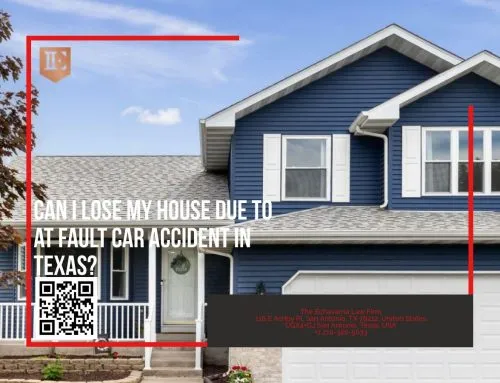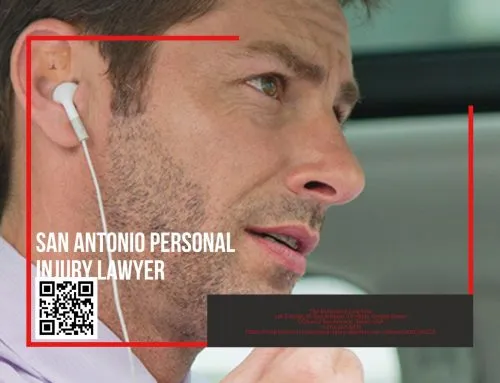Herniated discs are a common injury that can occur after a car accident, causing immense pain and discomfort for those affected. In this article, we will explore the causes, symptoms, diagnosis, and treatment options for herniated discs resulting from car accidents. We will also discuss how a car accident lawyer can assist with a herniated disc claim.
Get Car injury legal help now! The Echavarria Law Firm negotiates with insurance firms, secures compensation for serious motor vehicle crash injuries,san antonio car accident lawsuit, and holds driver accountable. Get a free case evaluation—call 210-320-5633 or visit us online. We help with back injuries resulting from Car accidents

Whether you have experienced a herniated disc yourself or are seeking to understand the implications of such injuries, this comprehensive guide will provide you with the essential knowledge you need to navigate this challenging situation.
What Is A Herniated Disc?
A herniated disc, also known as a slipped or ruptured disc, occurs when the soft center of a spinal disc pushes through a crack in the tougher exterior casing. This can happen due to trauma from a car accident or other injuries, leading to severe pain and discomfort.
When the soft gel-like material inside the disc protrudes, it can press on nearby nerves, causing numbness, weakness, or a tingling sensation in the arms or legs. In the context of car accidents, the sudden impact or force can exert tremendous pressure on the spine, leading to disc herniation. The diagnostic procedures for a herniated disc often involve imaging tests such as MRI or CT scans to visualize the affected area.
In San Antonio individuals involved in car accidents may face the ordeal of dealing with medical expenses, as herniated disc treatments can include physical therapy, medications, or in severe cases, surgery. These expenses can have a significant financial impact, adding to the stress and burden on the affected individuals.
What Causes A Herniated Disc After A Car Accident?
Several factors can contribute to the development of a herniated disc following a car accident, especially in cases involving significant trauma to the spine. In Texas, such incidents may exacerbate pre-existing conditions, leading to disc herniation and related complications.
Notably, the sudden impact of a car accident can exert immense pressure on the spinal column, causing the discs between the vertebrae to bulge or rupture. The forceful movement or jolt during a collision can disrupt the structural integrity of the spine, leading to herniation.
bustling urban areas and highways, car accidents can occur frequently, increasing the risk of spinal injuries. The combination of high-speed impacts and abrupt halts can significantly strain the spine, potentially resulting in disc herniation.
For individuals with pre-existing spinal conditions, such as degenerative disc disease or spinal stenosis, a car accident in San Antonio Texas can worsen these conditions, precipitating the onset of a herniated disc. The sudden trauma from the collision can aggravate the already vulnerable state of the spine, leading to a higher likelihood of disc herniation.
Sudden Impact
The sudden impact of a car accident can exert tremendous force on the spine, potentially causing a herniated disc. In San Antonio Texas, severe cases may necessitate spinal surgery to address the resulting complications.
Such force can place immense pressure on the discs between the vertebrae, leading to the protrusion of the soft inner core, resulting in a herniated disc.
Individuals in San Antonio facing this situation might experience intense pain, numbness, or weakness in the affected area, impacting their mobility and overall quality of life.
When conservative treatments fail to alleviate the pain and symptoms, spinal surgery can become a viable option for those seeking relief and restoration of function.
This intervention poses its own set of challenges, including the necessity for extensive rehabilitation and potential long-term effects on the individual’s spinal health.
Whiplash
Whiplash, commonly experienced in car accidents, can lead to disc protrusion and subsequent herniation. The forceful movement of the neck and spine can contribute to this painful condition.
The rapid back-and-forth motion during a collision can cause the discs between the vertebrae to shift or bulge, resulting in a herniated disc. In San Antonio Texas, where car accidents are unfortunately common, individuals affected by whiplash may develop this condition as a consequence of the sudden impact.
The progression of a herniated disc can lead to nerve compression, causing symptoms such as numbness, tingling, and weakness in the arms and legs. Seeking timely medical attention and proper treatment following a whiplash injury is essential to mitigate the potential development of a herniated disc.
Poor Posture
Poor posture, often exacerbated by the physical strains of a car accident, can contribute to the development of a herniated disc. In San Antonio Texas conservative treatments may be considered to address the resultant discomfort and pain.
A herniated disc, also known as a slipped or ruptured disc, can occur when the cushion-like substance between the vertebrae pushes out through a tear in the outer layer, causing pain, numbness, or weakness. The impact of poor posture on this condition is significant, as it puts undue stress on the spine and can exacerbate the existing damage from a car accident.
, the emphasis on conservative treatments such as physical therapy, chiropractic care, and non-invasive interventions reflects the acknowledgment of the potential long-term implications of untreated herniated discs.
Pre-existing Conditions
Individuals with pre-existing spinal conditions are at an increased risk of developing a herniated disc following a car accident in San Antonio . Epidural steroid injections may be recommended to alleviate the associated symptoms and discomfort.
This heightened susceptibility is due to the fragility of the spine in these cases, making it more prone to injury upon impact. The specific nature of the pre-existing condition can also contribute to the likelihood of a herniated disc. , where car accidents are unfortunately common, this issue holds particular relevance.
What Are The Symptoms Of A Herniated Disc After A Car Accident?
Following a car accident, the symptoms of a herniated disc may manifest as persistent pain, numbness, and tingling sensations, where the impact of such injuries can be pronounced.
The persistent pain associated with a herniated disc often radiates from the lower back down through the legs, known as sciatica. This can result in difficulty walking or standing for long periods. Numbness and tingling sensations may be felt in the affected area of the body, signaling nerve compression.
In , where car accidents are unfortunately common, individuals experiencing these symptoms should seek immediate medical attention to prevent any long-term complications or worsening of the condition.
Pain
Pain stemming from a herniated disc after a car accident can be debilitating, often necessitating specialized care such as chiropractic treatments to manage the discomfort effectively.
The physical pain caused by a herniated disc can disrupt daily activities and significantly impact the individual’s quality of life. where car accidents are unfortunately not uncommon, many individuals experience the intense discomfort and limitations associated with this condition.
The impact of this kind of pain goes beyond the purely physical, often affecting mental and emotional well-being. Chiropractic care offers a non-invasive, holistic approach to managing the symptoms of a herniated disc, providing relief and promoting long-term healing, making it an increasingly popular choice for individuals seeking natural and effective pain management.”
Numbness or Tingling
Numbness and tingling sensations resulting from a herniated disc following a car accident can indicate nerve damage, often requiring diagnostic procedures like discograms to assess the extent of the condition.
These symptoms can be alarming, as they suggest that the herniated disc may be pressing on a nerve, leading to potential long-term complications. When left untreated, nerve damage can result in chronic pain, weakness, and even loss of function. Therefore, it’s crucial for individuals who experience numbness and tingling after a car accident to seek prompt medical evaluation to determine the underlying cause and appropriate treatment.
Diagnostic assessments such as discograms play a vital role in providing detailed insights into the nature and location of the herniation, guiding physicians in formulating an effective treatment plan tailored to the patient’s specific condition.
Weakness
Weakness in specific muscle groups can arise as a symptom of a herniated disc following a car accident, often associated with conditions such as annular tears that worsen the overall discomfort.
Annular tears, which are small tears in the tough exterior of the spinal disc, can result from traumatic injuries like car accidents. When these tears occur, the inner gel-like substance of the disc can protrude, causing compression of the nearby nerves. This compression can lead to weakness in certain muscle groups, making everyday movements challenging for the affected individual.
In the context , where car accidents are unfortunately common, individuals with herniated discs and annular tears may find themselves grappling with not only physical weakness but also emotional and financial burdens. Seeking prompt medical attention and legal guidance is crucial for those dealing with the consequences of these injuries.
How Is A Herniated Disc Diagnosed?
Diagnosing a herniated disc commonly involves a combination of physical examinations and imaging tests,where the accurate assessment of such injuries is crucial for appropriate medical interventions.
Physical examinations play a pivotal role in identifying the symptoms associated with a herniated disc, such as nerve pain, muscle weakness, and numbness. These exams aid in understanding the extent of the injury and its impact on the patient’s daily life.
the emphasis on detailed physical assessments is essential due to the need for personalized treatment plans that consider the individual’s lifestyle and occupational demands.
Physical Examination
A thorough physical examination is crucial for diagnosing a herniated disc after a car accident . This typically includes assessments of range of motion, reflexes, and localized tenderness, complemented by relevant imaging studies such as X-rays.
During the physical examination, the healthcare provider evaluates the patient’s ability to move the affected area, as restricted movement may indicate a herniated disc. Reflex testing helps identify any abnormal responses, which can be indicative of nerve compression. The assessment of localized tenderness assists in pinpointing the exact area of discomfort, aiding in the diagnosis process.
specific considerations are taken into account during these examinations, as the impact of car accidents on spinal health is a significant concern in the state. X-rays play a complementary role in the diagnostic process by providing detailed images of the spine, enabling healthcare professionals to visualize any structural irregularities associated with a herniated disc.
Imaging Tests
Imaging tests, particularly MRIs, play a pivotal role in diagnosing a herniated disc following a car accident . They provide detailed insights into the location and severity of the disc injury, guiding subsequent treatment decisions.
For individuals involved in car accidents, the use of MRIs can be instrumental in revealing the extent of damage that may not be immediately apparent. These tests enable healthcare professionals to assess the exact location of the herniated disc, which is crucial in determining the appropriate treatment plan. MRIs offer a non-invasive way to visualize the soft tissue structures around the spine, aiding in accurate diagnosis, prognosis, and management of the injury. By providing comprehensive information, MRIs help in developing tailored treatment strategies to address the specific needs and ensure the best possible recovery for the patient.
What Are The Treatment Options For A Herniated Disc After A Car Accident?
The treatment options for a herniated disc resulting from a car accident encompass a spectrum of interventions, ranging from conservative treatments to surgical solutions, often necessitating compensation considerations for comprehensive healthcare.
Conservative treatments for herniated discs may include physical therapy, medication, and epidural steroid injections to manage pain and inflammation. On the other hand, surgical solutions like discectomy or spinal fusion may be considered in severe cases where conservative measures do not provide relief.
Patients who have sustained a herniated disc from a car accident may need comprehensive healthcare that involves not only physical treatment but also psychological support, rehabilitation, and ongoing medical monitoring. Legal aspects such as compensation for medical expenses, lost wages, and pain and suffering should also be part of the treatment considerations post-car accidents involving herniated discs.
Rest and Activity Modification
Rest and activity modification are essential components of the treatment regimen for a herniated disc following a car accident in San Antonio Texas. These measures support the healing process and mitigate potential aggravation of the injury.
Ensuring adequate rest allows the affected disc to recover, reducing inflammation and promoting tissue repair. It also minimizes the risk of further damage caused by overexertion or improper movement. In addition, activity modification is crucial in preventing activities that strain the spine, such as heavy lifting or prolonged sitting, to avoid exacerbating the condition.
For individuals in Texas recovering from a car accident-induced herniated disc, it’s important to consider the specific environmental factors, such as driving long distances and sitting in traffic, which could hinder recovery. Emphasizing the incorporation of rest breaks and ergonomic adjustments to daily activities can significantly aid in the healing process.
Physical Therapy
Physical therapy plays a pivotal role in the rehabilitation of individuals with a herniated disc following a car accident in San Antonio Texas, addressing issues such as spinal strain and facilitating functional recovery.
It provides targeted exercises and manual techniques to improve flexibility, strength, and pain management in affected areas. By focusing on restoring mobility and stability, physical therapy can alleviate discomfort and prevent the exacerbation of musculoskeletal conditions. Particularly in Georgia, where car accidents are unfortunately common, physical therapy offers a valuable means to address the specific challenges associated with herniated discs. The tailored approach of physical therapy enables individuals to regain their independence and quality of life by minimizing the impact of their injuries.
Medications
Medications, including pain relievers and anti-inflammatory drugs, are often prescribed to manage the symptoms of a herniated disc following a car accident in San Antonio Texasa, particularly in cases involving conditions like sciatica.
These medications play a crucial role in providing relief from the pain and inflammation associated with herniated discs, offering a sense of comfort and improved mobility to individuals affected by the condition.
Nonsteroidal anti-inflammatory drugs (NSAIDs) are commonly used to reduce inflammation and alleviate discomfort, while analgesic medications such as acetaminophen or opioids may be prescribed to manage severe pain. Muscle relaxants are frequently recommended to ease muscle spasms and enhance the overall treatment of the affected area.
Surgery
Surgical interventions may be warranted for severe cases of herniated discs resulting from car accidents in San Antonio Texas, particularly when complications such as disc degeneration and nerve compression are involved.
Car accidents can result in serious physical trauma, causing herniated discs due to the impact forces transmitted to the spine. In these severe cases, conservative treatments like physical therapy and medication may not provide sufficient relief. As a result, surgery becomes a viable option to alleviate persistent pain and neurological symptoms.
The specific challenges faced in San Antonio Texas, including the prevalence of road traffic incidents, underscore the need for accessible and advanced surgical interventions to address the complexities of herniated discs post-accidents.
How Can A Car Accident Lawyer Help With A Herniated Disc Claim?
Engaging the expertise of a car accident lawyer can significantly aid in navigating the legal and insurance aspects of a herniated disc claim, ensuring thorough representation and pursuit of rightful compensation.
Car accident lawyers play a pivotal role in advocating for individuals who have suffered from a herniated disc due to car accidents. They possess the legal knowledge and experience necessary to effectively negotiate with insurance companies and other parties involved.
These lawyers are well-versed in the complexities of personal injury law, allowing them to build strong cases and present compelling arguments on behalf of their clients. Their expertise extends to understanding the medical and financial implications of herniated discs, enabling them to pursue maximum compensation for their clients’ damages.
Car accident lawyers provide invaluable support and guidance throughout the entire claims process, from gathering evidence to representing their clients in court if necessary. Their dedication to securing just outcomes for herniated disc victims underscores their importance in seeking rightful compensation.
Frequently Asked Questions
What is a herniated disc and how does it happen after a car accident?
A herniated disc occurs when the soft tissue between the bones of the spine becomes damaged or ruptured. This can happen after a car accident when the impact causes the spine to move in an unnatural way, putting pressure on the discs.
What are the symptoms of a herniated disc after a car accident?
The most common symptom of a herniated disc is pain in the affected area, as well as numbness, tingling, and weakness in the arms or legs. Other symptoms may include muscle spasms, difficulty walking, and decreased range of motion.
How is a herniated disc diagnosed after a car accident?
Your doctor will likely perform a physical exam and may order imaging tests such as an X-ray or MRI to confirm the diagnosis of a herniated disc. They will also take into account your medical history and any symptoms you are experiencing.
Can a herniated disc heal on its own after a car accident?
In some cases, a herniated disc may heal on its own with rest, physical therapy, and other non-invasive treatments. However, severe cases may require surgery to repair the damaged disc. It is important to seek medical attention and follow your doctor’s recommendations for treatment.
How long does it take to recover from a herniated disc after a car accident?
Recovery time can vary depending on the severity of the herniated disc and the chosen treatment plan. It may take a few weeks to several months for symptoms to fully subside. Your doctor will be able to give you a more accurate estimate based on your individual case.
Can I receive compensation for a herniated disc after a car accident?
If the car accident was caused by another party’s negligence, you may be entitled to compensation for your medical expenses, lost wages, and pain and suffering. It is important to consult with a personal injury lawyer to determine your legal options and ensure you receive fair compensation.




